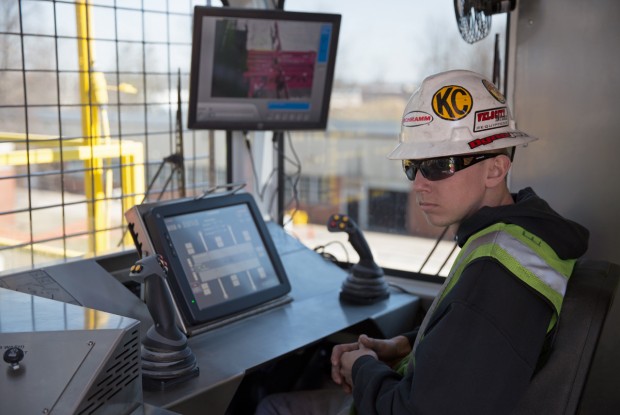Gas industry survey shows job growth slowing

Lindsay Lazarski/WHYY
Ethan Eckard, 23, a test technician at Schramm, Inc. in West Chester, sits in the control room of the T500XD drill rig.
Job growth in the Marcellus Shale industry continues, but it’s slowing down.
That’s according to an annual workforce survey published today by the gas industry trade group, the Marcellus Shale Coalition. Companies expect to hire 2,000 new workers this year– a 50 percent drop from the 4,000 jobs they projected last year.
Over the past few years, booming business led to overproduction– producing a glut of gas that caused prices to plummet.
“I think it’s pretty clear we’ve been a victim of our own success,” says MSC President Dave Spigelmyer. “Natural gas prices have softened rather dramatically.”
As companies have shifted operations from the dry gas regions of Pennsylvania’s northern tier, toward the more lucrative wet gas in the southwestern part of the state, the survey projects most of the job growth this year will happen there.
The report includes responses from 60 of the coalition’s 288 member companies.
Spigelmyer points out the survey focuses on direct oil and gas jobs and doesn’t capture other employment benefits, like lower natural gas prices making Pennsylvania manufacturing more competitive. He says as drill rigs move elsewhere, job opportunities also shift.
“We’ve seen the job growth occurring primarily in the downstream sector—building out our pipeline infrastructure,” he says.
According to the survey, the share of new jobs going to Pennsylvanians increased slightly last year–up from 57 percent in 2012 to 60 percent in 2013.
Most of the new hires last year were in engineering and consulting, equipment operations, and operations/maintenance.
The industry continues to lack diversity with 84 percent of its workforce listed as white. Latinos and blacks make up six and four percent of workers, respectively. Men outnumber women three to one.
The top three challenges in recruiting new workers remained unchanged. Companies cite a lack of qualified talent, competition for those who are qualified, and an unwillingness to relocate among prospective employees.
Despite anecdotal evidence to the contrary, most gas companies continue to say drug use is “not at all” an issue in recruiting workers.
According to the most recent figures from the Pennsylvania Department of Labor, about 28,000 people work directly in oil and gas jobs. Nationally, oil and gas jobs have increased by 27 percent between 2007 and 2012, making it one of the fastest-growing sectors of the economy, according to a report published earlier this year by the U.S. Census Bureau.
















